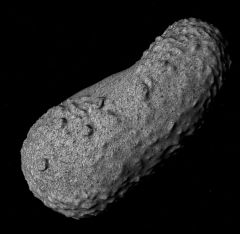25143 Itokawa
25143 Itokawa is a Near-Earth object discovered in 1998 by LINEAR project and named for the Japanese rocket engineer Hideo Itokawa.
Itokawa in Orbiter
Itokawa is a Near-Earth object released by T1234 in the add-on 3D Asteroids in November 2014. Modeled as a 45 km body in an eccentric orbit of .28 with a Semimajor axis of about 1.3 AU, it is considerably larger than the actual Itokawa which is about 330 meters average diameter.
The hard landing surface is very much below the visual surface, anywhere from about 30 km to 100 km below. It is modeled at a elongated object with a rough surface.
See also
Gallery
25143 Itokawa imaged by the Hayabusa spacecraft in September 2005
| edit The Solar System | |
|---|---|
| Central star |
Sun (Sol) |
| Planets |
Mercury - Venus - Earth - Mars - Jupiter - Saturn - Uranus - Neptune |
| Natural satellites |
Moon - Phobos - Deimos - Io - Europa - Ganymede - Titan - more... |
| Add-ons |
Planets - Dwarf Planets - Small objects - Natural satellites - Alternative star systems |



